

Microservices - Des architectures. Microservices.
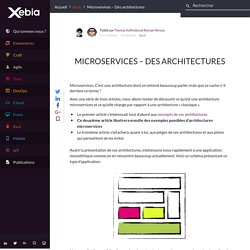
C’est une architecture dont on entend beaucoup parler, mais que se cache-t-il derrière ce terme ? Avec une série de trois articles, nous allons tenter de découvrir ce qu’est une architecture microservices et ce qu’elle change par rapport à une architecture « classique ». Le premier article s’intéressait tout d’abord aux concepts de ces architecturesCe deuxième article illustrera ensuite des exemples possibles d’architectures microservicesLe troisième article s’attachera, quant à lui, aux pièges de ces architectures et aux pistes qui permettent de les éviter Avant la présentation de ces architectures, intéressons nous rapidement à une application monolithique comme on en rencontre beaucoup actuellement. Voici un schéma présentant ce type d’application: Notre application est faite d’un seul package, toutes les couches communiquent entres elles via des appels de méthodes. Microservices en REST L’organisation de notre application ressemblera à ceci :
Initiation à Docker. Dans ce workshop, vous aurez à votre disposition une instance amazon.

Vous pouvez également utiliser directement votre machine, ou si vous le préférez, une machine virtuelle. Toutes les machines utilisent la même clef ssh, et ont le même login ubuntu. Pour vous connecter à votre machine, placez le fichier docker-janvier.pem ou le fichier docker-janvier.ppk pour les utilisateurs Windows, dans votre répertoire courant (la clef sera révoquée après le workshop). N'oubliez pas de changer les permissions sur le fichier : GitHub - kubernetes/kubernetes: Container Cluster Manager from Google. Documentation. These docs cover signing, downloading and running containers, as well as high level design thinking and motivations for rkt.
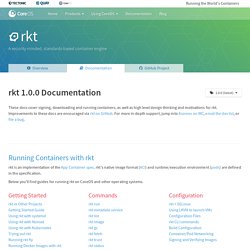
Improvements to these docs are encouraged via rkt on GitHub. For more in-depth support, jump into #coreos on IRC, email the dev list, or file a bug. rkt is an implementation of the App Container spec. rkt's native image format (ACI) and runtime/execution environment (pods) are defined in the specification. Below you'll find guides for running rkt on CoreOS and other operating systems. Lelylan Dev Center. Building the Connected Home. Overview Lelylan breaks up the Internet of Things complexities by providing a highly elastic and highly scalable way to build, deploy and manage modern iot applications based on microservices.
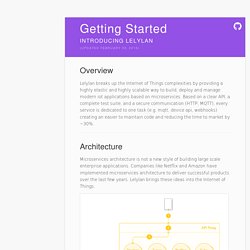
Based on a clear API, a complete test suite, and a secure communication (HTTP, MQTT), every service is dedicated to one task (e.g. mqtt, device api, webhooks) creating an easier to maintain code and reducing the time to market by ~30%. Architecture Microservices architecture is not a new style of building large scale enterprise applications. Companies like Netflix and Amazon have implemented microservices architecture to deliver successful products over the last few years.
Architecture → Installation Lelylan provides many blocks you need to run an connected product at scale in production. Installation → Tutorials. AngularJS directive to control your devices, on web and mobile. In this section you will learn how to use the device directive to monitor and control all the devices you have defined in Lelylan.
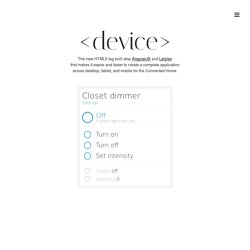
The oauth directive has beed tested with AngularJS 1.2.x (legacy version). Open an issue on Github if any problem occurs when using the AngularJS 1.3.x or 2.x versions. Setup To build our app we'll use Yeoman, a collection of tools and frameworks helping developers to quickly build web applications. yo - perform ripetitive tasks. Installation. GitHub - mcollina/mosca: MQTT broker as a module. Nearform/nscale. Oneops/adapter: webapp to provide rest interface to cms db. Docker Tutorial Series. Unless you have intentionally decided to block any news around software in your social feeds, it is likely that you have heard about Docker.
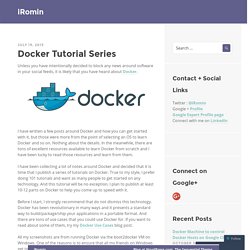
I have written a few posts around Docker and how you can get started with it, but those were more from the point of selecting an OS to learn Docker and so on. Nothing about the details. In the meanwhile, there are tons of excellent resources available to learn Docker from scratch and I have been lucky to read those resources and learn from them. I have been collecting a lot of notes around Docker and decided that it is time that I publish a series of tutorials on Docker. True to my style, I prefer doing 101 tutorials and want as many people to get started on any technology. Docker Hub. Rapidly develop Internet of Things apps with Docker Containers. Containers overview The Internet of Things, the highly connected network of smart devices, such as environmental sensors, medical trackers, home appliances, and industrial devices, is growing rapidly.
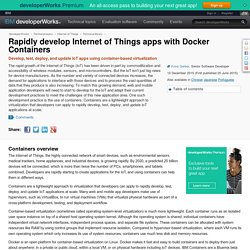
By 2020, a predicted 20 billion devices will be connected, which is more than twice the number of PCs, smartphones, and tablets combined. Developers are rapidly starting to create applications for the IoT, and using containers can help them in different ways. Containers are a lightweight approach to virtualization that developers can apply to rapidly develop, test, deploy, and update IoT applications at scale. Many web and mobile app developers make use of hypervisors, such as VirtualBox, to run virtual machines (VMs) that virtualize physical hardware as part of a cross-platform development, testing, and deployment workflow.
Container-based virtualization (sometimes called operating-system-level virtualization) is much more lightweight. Back to top. Scaling Docker with Swarm. We are extremely excited to announce the first beta release of Swarm, a native clustering tool for Docker.

For the past two years, Docker has made the lives of millions of developers easier by making building, shipping and running applications simpler through containers. However, things get complicated when dealing with more than one host for Docker containers in a distributed environment. This is where Swarm comes in. IBM Containers: A Bluemix Runtime Leveraging Docker Technology. Présentation Docker. Docker Hub. Tous les tutoriels Docker. Downloads · Docker Pirates ARMed with explosive stuff.